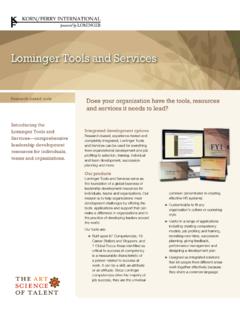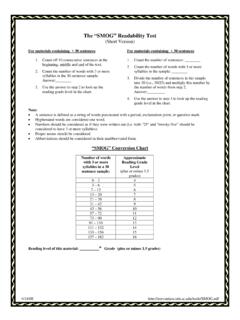Transcription of 1818 H Street, N.W. Telex: MCI 64145 WORLDBANK MCI …
1 W O R L D B A N K O P E R A T I O N S E V A L U A T I O N D E PA R T M E N T E V A L U A T I O N C A PA C I T Y D E V E L O P M E N T. T H E W O R L D. 1818 H Street, B A N K. MONITORING. Washington, 20433, Telephone: 202-477-1234. Facsimile: 202-477-6391. Telex: MCI 64145 WORLDBANK . MCI 248423 WORLDBANK . Internet: Operations Evaluation Department Knowledge Programs and Evaluation Capacity Development Group (OEDKE). E-mail: Telephone: 202-458-4497. &. EVALUATION: Facsimilie: 202-522-3125 Some Tools, Methods & Approaches MONITORING. &. EVALUATION: Some Tools, Methods & Approaches The World Bank Washington, N. Acknowledgments The first edition of this report was prepared by Mari Clark and Rolf Sartorius (Social Impact). A number of World Bank staff who made substantive contributions to its preparation are gratefully acknowledged, including Francois Binder, Osvaldo Feinstein, Ronnie Hammad, Jody Kusek, Linda Morra, Ritva Reinikka, Gloria Rubio and Elizabeth White. This second edition includes an expanded discussion of impact evaluation, prepared by Michael Bamberger (consultant).
2 The task manager for finalization of this report was Keith Mackay. Copyright 2004. The International Bank for Reconstruction and Development/THE WORLD BANK. 1818 H Street, Washington, 20433, All rights reserved. Manufactured in the United States of America The opinions expressed in this report do not necessarily represent the views of the World Bank or its member governments. The World Bank does not guar- antee the accuracy of the data included in this publication and accepts no responsibility whatsoever for any consequence of their use. The boundaries, colors, denominations, and any other information shown on any map in this volume do not imply on the part of the World Bank Group any judgement on the legal status of any territory or the endorsement or acceptance of such boundaries. W O R L D B A N K O P E R A T I O N S E V A L U A T I O N D E P A R T M E N T. E V A L U A T I O N C A P A C I T Y D E V E L O P M E N T. 3. Table of Contents M&E Overview ..5. Performance Indicators ..6. The Logical Framework Approach.
3 8. Theory-Based Evaluation ..10. Formal Surveys ..12. Rapid Appraisal Methods ..14. Participatory Methods ..16. Public Expenditure Tracking Surveys ..18. Cost-Benefit and Cost-Effectiveness Analysis ..20. Impact Evaluation ..22. Additional Resources on Monitoring and Evaluation ..25. W O R L D B A N K O P E R A T I O N S E V A L U A T I O N D E P A R T M E N T. E V A L U A T I O N C A P A C I T Y D E V E L O P M E N T. 5. M&E OVERVIEW: SOME TOOLS, METHODS AND APPROACHES FOR. MONITORING AND EVALUATION. Monitoring and evaluation (M&E) of develop- PURPOSE ment activities provides government officials, development managers, and civil society with better means for learning from past experience, improving service delivery, planning and allocating resources, and demonstrating results as part of accountability to key stakeholders. Within the development community there is a strong focus on results . this helps explain the growing interest in M&E. Yet there is often confusion about what M&E entails.
4 The purpose of this M&E Overview is to strengthen awareness and interest in M&E, and to clarify what it entails. You will find an overview of a sample of M&E tools, methods, and approaches outlined here, including their purpose and use; advantages and disadvantages; costs, skills, and time required; and key references. Those illus- trated here include several data collection methods, analytical frameworks, and types of evaluation and review. The M&E Overview discusses: Performance indicators The logical framework approach Theory-based evaluation Formal surveys Rapid appraisal methods Participatory methods Public expenditure tracking surveys Cost-benefit and cost-effectiveness analysis Impact evaluation This list is not comprehensive, nor is it intended to be. Some of these tools and approaches are complementary; some are substitutes. Some have broad applicability, while others are quite narrow in their uses. The choice of which is appropriate for any given context will depend on a range of considerations.
5 These include the uses for which M&E is intended, the main stakeholders who have an interest in the M&E findings, the speed with which the information is needed, and the cost. N. 6. Performance Indicators What are they? Performance indicators are measures of inputs, processes, outputs, outcomes, and impacts for development projects, programs, or strategies. When supported with sound data collection perhaps involving formal surveys analysis and reporting, indicators enable managers to track progress, demonstrate results, and take corrective action to improve service delivery. Participation of key stakeholders in defining indicators is important because they are then more likely to understand and use indicators for management decision-making. What can we use them for? Setting performance targets and assessing progress toward achieving them. Identifying problems via an early warning system to allow corrective action to be taken. Indicating whether an in-depth evaluation or review is needed.
6 ADVANTAGES: Effective means to measure progress toward objectives. Facilitates benchmarking comparisons between different organizational units, districts, and over time. DISADVANTAGES: Poorly defined indicators are not good measures of success. Tendency to define too many indicators, or those without accessible data sources, making system costly, impractical, and likely to be underutilized. Often a trade-off between picking the optimal or desired indicators and having to accept the indicators which can be measured using existing data. COST: Can range from low to high, depending on number of indicators collected, the fre- quency and quality of information sought, and the comprehensiveness of the system. W O R L D B A N K O P E R A T I O N S E V A L U A T I O N D E P A R T M E N T. E V A L U A T I O N C A P A C I T Y D E V E L O P M E N T. 7. SKILLS REQUIRED: Several days of training are recommended to develop skills for defining practical indicators. Data collection, analysis and reporting skills, and management information system (MIS) skills are required to implement performance monitoring systems.
7 TIME REQUIRED: Several days to several months, depending on extent of participatory process used to define indicators and program complexity. Implementing performance monitoring systems may take 6 12 months. F O R M O R E I N F O R M A T I O N : World Bank (2000). Key Performance Indicator Handbook. Washington, Hatry, H. (1999). Performance Measurement: Getting Results. The Urban Institute, Washington, N. 8. The Logical Framework Approach What is it? The logical framework (LogFrame) helps to clarify objectives of any project, program, or policy. It aids in the identification of the expected causal links the program logic in the following results chain: inputs, processes, outputs (including coverage or reach across beneficiary groups), outcomes, and impact. It leads to the identification of performance indicators at each stage in this chain, as well as risks which might impede the attainment of the objectives. The LogFrame is also a vehicle for engaging partners in clarifying objectives and designing activities.
8 During implementation the LogFrame serves as a useful tool to review progress and take corrective action. What can we use it for? Improving quality of project and program designs by requiring the specification of clear objectives, the use of performance indicators, and assessment of risks. Summarizing design of complex activities. Assisting the preparation of detailed operational plans. Providing objective basis for activity review, monitoring, and evaluation. ADVANTAGES: Ensures that decision-makers ask fundamental questions and analyze assumptions and risks. Engages stakeholders in the planning and monitoring process. When used dynamically, it is an effective management tool to guide implementa- tion, monitoring and evaluation. DISADVANTAGES: If managed rigidly, stifles creativity and innovation. If not updated during implementation, it can be a static tool that does not reflect changing conditions. Training and follow-up are often required. W O R L D B A N K O P E R A T I O N S E V A L U A T I O N D E P A R T M E N T.
9 E V A L U A T I O N C A P A C I T Y D E V E L O P M E N T. 9. COST: Low to medium, depending on extent and depth of participatory process used to support the approach. SKILLS REQUIRED: Minimum 3 5 days training for facilitators; additional facilitation skills required for use in participatory planning and management. TIME REQUIRED: Several days to several months, depending on scope and depth of participatory process. F O R M O R E I N F O R M A T I O N : World Bank (2000). The Logframe Handbook, World Bank: http://wbln1023/ $ GTZ (1997). ZOPP: Objectives-Oriented Project Planning: N. 10. Theory-Based Evaluation What is it? Theory-based evaluation has similarities to the LogFrame approach but allows a much more in-depth understanding of the workings of a program or activity the program theory or program logic. In particular, it need not assume simple linear cause-and- effect relationships. For example, the success of a government program to improve liter- acy levels by increasing the number of teachers might depend on a large number of fac- tors.
10 These include, among others, availability of classrooms and textbooks, the likely reactions of parents, school principals and schoolchildren, the skills and morale of teach- ers, the districts in which the extra teachers are to be located, the reliability of govern- ment funding, and so on. By mapping out the determining or causal factors judged important for success, and how they might interact, it can then be decided which steps should be monitored as the program develops, to see how well they are in fact borne out. This allows the critical success factors to be identified. And where the data show these factors have not been achieved, a reasonable conclusion is that the program is less likely to be successful in achieving its objectives. What can we use it for? Mapping design of complex activities. Improving planning and management. ADVANTAGES: Provides early feedback about what is or is not working, and why. Allows early correction of problems as soon as they emerge. Assists identification of unintended side-effects of the program.

















